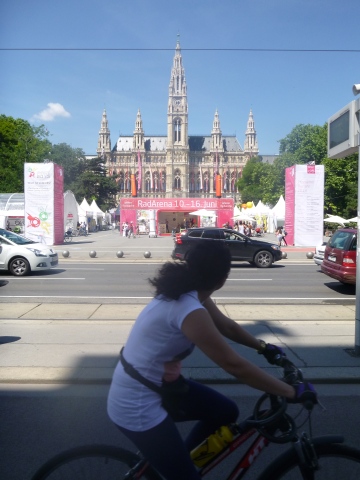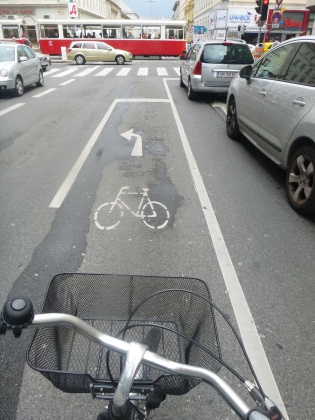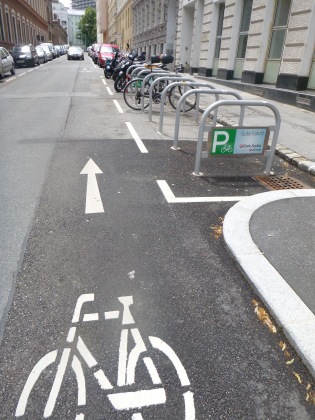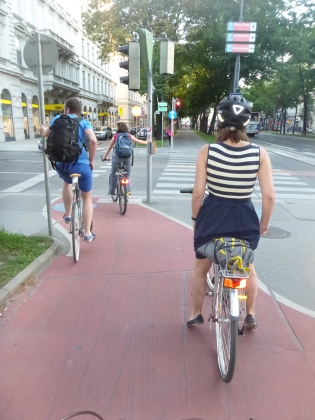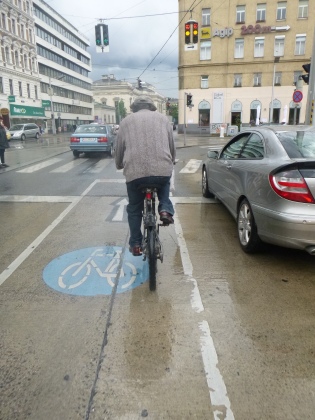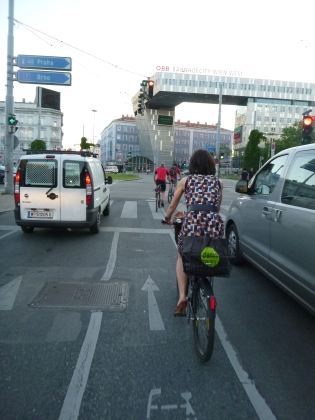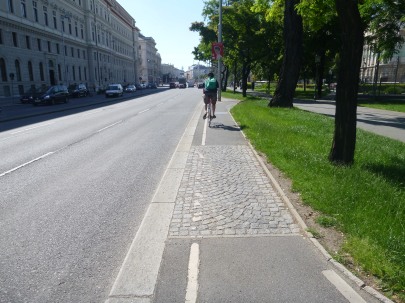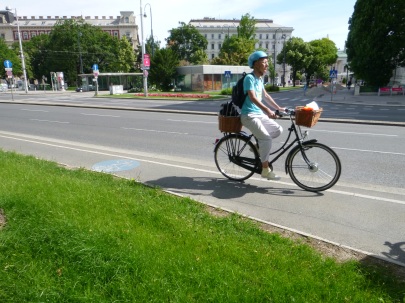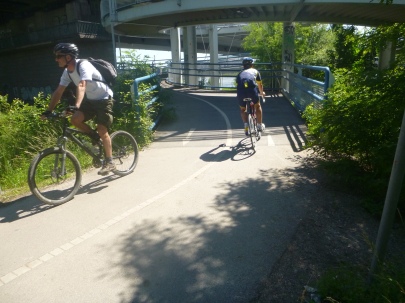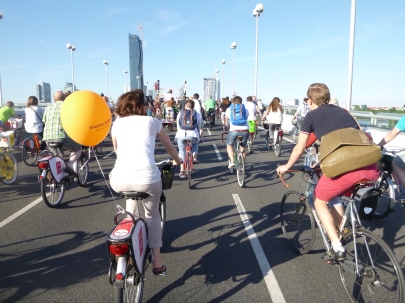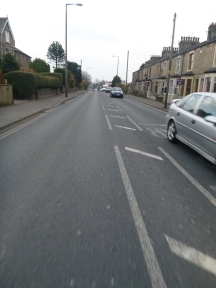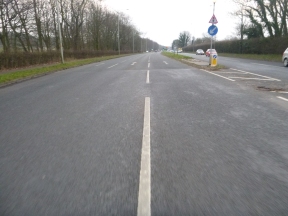After presenting on ‘Fear of Cycling’ to the Velo-city Vienna conference recently, I was asked to summarise my talk for the post-conference magazine. It’s lost some nuance and complexity but I’ve got the argument down to 1,000 words, and post it below for anyone interested. I do so because Velo-city reminded me how ‘live’ is the issue of helmets, particularly – helmets look set to become mandatory in Spain, and already are in Australia – where next year’s Velo-city takes place, in Adelaide; so it seems not everyone yet knows how huge an impediment to mass cycling is helmet promotion, let alone compulsion.
Introduction
Cycling is so good, yet many people still don’t cycle. Why? We must start by recognising how cycling conditions remain so generally poor; to do otherwise is naïve. Most people simply don’t want to, and won’t, cycle along roads dominated by fast, motorised traffic; the thought of riding amongst or close to big, heavy vehicles is one they find very scary. Nobody wants to get hurt and, rightly or wrongly, people feel getting hurt is more likely if they move by bike.
For anyone who wants to see more cycling, the instinct here is to try to persuade people that cycling is actually, really safe. We might explain how cycling is:
- objectively safe – the chances of a crash when cycling are very slim;
- relatively safe – for example, there is more chance of being injured when cooking than when cycling;
- much safer than not cycling – the health benefits of cycling, it’s said, outweigh the risks by 20:1.
Better still, we might try not only to encourage people to ride despite their fears, but meanwhile also push for substantial – radical – improvements to current conditions for cycling. But the question remains: why is cycling – something which perhaps gives us pleasure and benefit – in the minds of other people so worrying? Yes, people might overstate cycling’s risks. Yes, more must be done to make cycling (feel) safer. But might there also be cultural and political processes at work which make cycling seem dangerous, more dangerous than it is, and which produce fear of cycling? And if this was the case, and we identified those processes, couldn’t, shouldn’t we intervene, to stop them?
Emotions can be, and are, constructed. Cycling is not inherently dangerous and a fear of cycling is not inevitable. We need only look to the Netherlands to see that – cycling there is so normal that people barely even think about it. But across most of the world cycling is more problematic, with many people reluctant to cycle because they think it’s dangerous.
How is fear of cycling produced?
So let’s examine how fear of cycling is produced. There are three clear ways in which cycling is made to seem more dangerous than it is. Ironically they all purport to be responding to cycling’s danger and to be making cycling safer, but instead they produce cycling as a dangerous practice, and thus contribute to fear of cycling; they do, in other words, the opposite of what they intend.
1. Road safety education
Road safety education teaches everyone, but particularly children, that moving around is risky, roads are dangerous, and they ought to be very careful, especially when walking and cycling. You know the kind of thing – leaflets telling children to keep out the way of cars. Such ‘information’ reinforces driving as the normal means of moving around, and makes cycling seem difficult, awkward and dangerous; it usually puts responsibility for safety squarely on the (child) cyclist’s shoulders – it’s up to you to devise a quiet route (however long), to wear hi-viz clothes and (of course!) a helmet. Road safety education doesn’t make places safer; it makes driving more normal and cycling more dangerous; and it seems often deliberately designed to instil fear of cycling.
2. Helmet promotion
In a context marked by widespread fear of cycling, promoting helmets – or even making them mandatory – can seem like an easy, obvious, quick and sensible thing to do. Which is why it’s done. But this is no way to promote cycling, because promoting helmets depends on associating cycling with danger, and will therefore inevitably increase fear of cycling. Like road safety education, helmet promotion puts responsibility onto the wrong people; and instead of making streets safer, makes cycling more dangerous. To promote helmets is to promote car use and to repress cycling.
3. New (safe) spaces for cycling
If fear stops most people riding, an obvious solution is to change cycling’s place. And in the short to medium term this might be a necessary step to overcoming fear of cycling, getting more people riding, and building a mass culture of cycling. But can you see how the logic here remains similar to the previous two examples? We try to make cycling safer without tackling the root problem, the danger imposed by fast motorised traffic. And with similar results – the impulse to take cycling off the road inevitably increases people’s fear of cycling on the road, and also makes those who remain cycling on the road a bit more ‘strange’.
So all three attempts to make cycling safer actually make cycling (seem) more dangerous, and produce a fear of cycling whilst failing to change how most people, most of the time, move around (which across most of the world, is increasingly by car). And so cycling remains in the minority, and the cyclist remains strange.
Conclusion
But we’re trying to promote cycling aren’t we? Yes, apparently, and we shouldn’t be surprised if there’s discomfort about (even resentment and resistance towards) the push for cycling – because by inviting people to cycle we’re asking them to become different. However, cycling would be more successfully promoted if we stopped making it seem dangerous and difficult, and worked instead to make it the simplest, easiest thing in the world. The sooner we make cycling normal, the sooner people will stop feeling cycling is a strange thing to do.
So finally then, how do we combat fear of cycling and make cycling normal?
- From the bottom-up – by grassroots empowerment, communicating cycling’s benefits, and helping people insert cycling more effectively into their lives. The more people cycle, the safer cycling becomes;
- From the top-down – by explaining to our governing institutions how cycling remains much too difficult and dangerous, and requires radical political re-prioritisation. The more cycling is prioritised, the safer cycling becomes;
- From everywhere – by shifting away from the misguided attempts to make cycling safer discussed here (with the caveat that high-quality dedicated cycling infrastructure is often now a necessary step to mainstreaming cycling), and concentrating instead on making motorised traffic less dangerous – by for example increasing restraints on driving, slowing speeds, and enforcing careful driving. The more we recognise the real danger to be driving, the safer cycling becomes.
Fear of cycling can be otherwise, but we must work to make it so.

